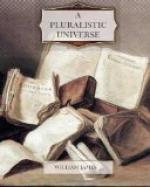For aught this argument proves, then, we may continue to believe that one thing can be known by many knowers. But the denial of one thing in many relations is but one application of a still profounder dialectic difficulty. Man can’t be good, said the sophists, for man is man and good is good; and Hegel and Herbart in their day, more recently H. Spir, and most recently and elaborately of all, Mr. Bradley, inform us that a term can logically only be a punctiform unit, and that not one of the conjunctive relations between things, which experience seems to yield, is rationally possible.
Of course, if true, this cuts off radical empiricism without even a shilling. Radical empiricism takes conjunctive relations at their face-value, holding them to be as real as the terms united by them. The world it represents as a collection, some parts of which are conjunctively and others disjunctively related. Two parts, themselves disjoined, may nevertheless hang together by intermediaries with which they are severally connected, and the whole world eventually may hang together similarly, inasmuch as some path of conjunctive transition by which to pass from one of its parts to another may always be discernible. Such determinately various hanging-together may be called concatenated union, to distinguish it from the ‘through-and-through’ type of union, ‘each in all and all in each’ (union of total conflux, as one might call it), which monistic systems hold to obtain when things are taken in their absolute reality. In a concatenated world a partial conflux often is experienced. Our concepts and our sensations are confluent; successive states of the same ego, and feelings of the same body are confluent. Where the experience is not of conflux, it may be of conterminousness (things with but one thing between); or of contiguousness (nothing between); or of likeness; or of nearness; or of simultaneousness; or of in-ness; or of on-ness; or of for-ness; or of simple with-ness; or even of mere and-ness, which last relation would make of however disjointed a world otherwise, at any rate for that occasion a universe ‘of discourse.’ Now Mr. Bradley tells us that none of these relations, as we actually experience them, can possibly be real.[1] My next duty, accordingly, must be to rescue radical empiricism from Mr. Bradley. Fortunately, as it seems to me, his general contention, that the very notion of relation is
[Footnote 1: Here again the reader must beware of slipping from logical into phenomenal considerations. It may well be that we attribute a certain relation falsely, because the circumstances of the case, being complex, have deceived us. At a railway station we may take our own train, and not the one that fills our window, to be moving. We here put motion in the wrong place in the world, but in its original place the motion is a part of reality. What Mr. Bradley means is nothing like this, but rather that such things as motion are nowhere real, and that, even in their aboriginal and empirically incorrigible seats, relations are impossible of comprehension.]




